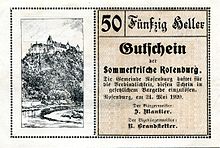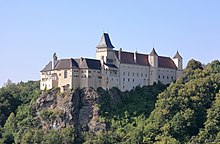Rosenburg mold
|
Rosenburg mold
|
||
|---|---|---|
| coat of arms | Austria map | |
|
|
||
| Basic data | ||
| Country: | Austria | |
| State : | Lower Austria | |
| Political District : | horn | |
| License plate : | HO | |
| Main town : | Rosenburg | |
| Surface: | 30.67 km² | |
| Coordinates : | 48 ° 38 ' N , 15 ° 42' E | |
| Height : | 268 m above sea level A. | |
| Residents : | 850 (January 1, 2020) | |
| Population density : | 28 inhabitants per km² | |
| Postal code : | 3573 | |
| Area code : | 02982 | |
| Community code : | 3 11 21 | |
| NUTS region | AT124 | |
| Address of the municipal administration: |
Rosenburg 25 3573 Rosenburg-Mold |
|
| Website: | ||
| politics | ||
| Mayor : | Wolfgang Schmöger ( ÖVP ) | |
|
Municipal Council : ( 2020 ) (15 members) |
||
| Location of Rosenburg-Mold in the Horn district | ||
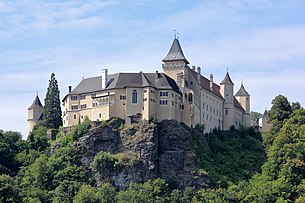 View of the Rosenburg |
||
| Source: Municipal data from Statistics Austria | ||
Rosenburg-Mold is a municipality with 850 inhabitants (as of January 1, 2020) in Lower Austria in the Horn district in the Waldviertel . The municipal administration is located in Rosenburg .
geography
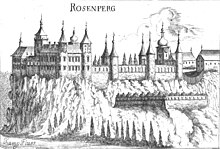
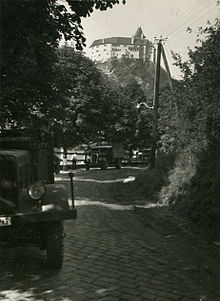
Rosenburg-Mold is located at an altitude of 268 m in the Waldviertel south of Horn on the edge of the Horner Basin and in the Kamptal. The Kamp and the Taffa , which flow into the Kamp in the center of Rosenburg, flow through the municipality . The area of the municipality covers 30.66 square kilometers. 38.14 percent of the area is forested.
Community structure
![]() Map with all coordinates: OSM | WikiMap
Map with all coordinates: OSM | WikiMap
|
structure
|
||||||
|
Legend for the breakdown table
|
The municipality includes the following localities (population in brackets as of January 1, 2020):
- Mold (317) with Maria Dreieichen
- Mortersdorf (128)
- Rosenburg (326)
- Stallegg (16)
- Fencing Pit (63)
With the Lower Austria. Local structural improvements were on 1 January 1967 the municipalities Mold with Maria Dreieichen, Mörtersdorf and Zaingrub to the municipality Mold. The municipality of Rosenburg-Mold was created in 1971 by merging the municipalities of Rosenburg with Stallegg and Mold.
The responsible judicial district is Horn
The cadastral community of Stallegg has the postcode 3571, Rosenburg 3573, Mold (excluding Maria Dreieichen) and Mörtersdorf and Zaingrub have the postcode 3580, the Molder district Maria Dreieichen has the postcode 3744.
The community Rosenburg-Mold is a member of the small region Kamp-Taffatal .
Neighboring communities
| horn | ||
| Altenburg |

|
Meiseldorf |
| Gars am Kamp | Burgschleinitz-Kühnring |
history
Prehistory and early history
The valley floor of the Kamptal in the area of Rosenburg was already settled in the Neolithic Age. In the district of Hofmühle, in an area sloping down towards the Kamp , between the state road to Altenburg, the road to Rosenburg and the former mill ditch of the Hofmühle, important finds from various times were made during several excavations in the 1980s and 1990s. In the north-western part of the find zone, a settlement from the early Neolithic (5500-5000 BC) with numerous finds of older linear ceramics has been documented. In the eastern part of the site, a Middle Neolithic (5000–4500 / 4300 BC) circular moat system and findings from the Latène period (5th – 1st century BC) have been identified. The entire discovery zone, which also includes an early medieval Slavic settlement, is a listed archaeological monument . On the heights of the Taffa Valley near its confluence with the Kamp, settlement finds from the Late Neolithic (3500-2800 BC), the Urnfield Culture (1300 BC to 800 BC) and the Hallstatt Period (1200-450 BC) have been found .) proven. The Mold area was also settled in the Neolithic. Between 1995 and 2007, several excavations made important discoveries of linear ceramics . Mörtersdorf was settled in the Middle Bronze Age (1600-1300 BC), as evidenced by a burial mound from this time. In addition to litter finds from the Neolithic Age, settlement remains from the younger Iron Age (450 BC - end of the 1st century BC) and Germanic settlement findings - including a reduction furnace for iron production - from the 1st to 4th centuries AD were found in Zaingrub . Be proven.
History of the Middle Ages and Modern Times
The Kamptal in Rosenburg was also settled in the early Middle Ages. Opposite the former court or Thurnmühle on the road to Rosenburg was a Slavic settlement from the early Middle Ages (approx. 600–800 AD) with several residential and farm buildings . Since the 12th century, the history of the place has been closely linked to the development of the Rosenburg , one of the largest castle complexes in Austria, which was first mentioned around 1150. At the end of the 16th and early 17th centuries, when the Protestant estates owned the Rosenburg palace and dominion, the Rosenburg became a center of Protestantism in Austria. Protestant literature was printed in a printing press set up especially in the castle. In the course of the Counter-Reformation , the Rosenburg received a Catholic lord again in 1611 with Cardinal Franz von Dietrichstein (1570–1636). In 1659 the castle and lordship came into the possession of Johann Joachim Enzmilner, Count of Windhag (1600–1678), who had the castle expanded. In the second edition of the topography Topographia Windhagiana published by him in 1673 , he had Clemens Beutler (around 1623–1682) not only depict the Rosenburg itself, but also the four mills on the Kamp and the town from a bird's eye view in numerous copper engravings.
The nearby town of Mold also benefited from the beginning of the pilgrimage to Maria Dreieichen in the late 17th century. Since the end of the 18th century, the Rosenburg fell into disrepair. Because of its three flour mills , a paper mill , a cloth whale and a wooden rake, on which the wood rafted from the upper Kamptal was recovered until 1907 , Rosenburg was of regional economic importance. With the renovation of the Rosenburg in 1859–1875 and the commissioning of the Kamptalbahn in 1889 , Rosenburg and Stallegg developed into an important summer resort in the Kamptal, along with Gars am Kamp , Schönberg am Kamp and Langenlois , from which Mold, Mörtersdorf and Zaingrub also came from - if also far more modest ones - summer visitors benefited. In 1920, like many other communities, the Rosenburg community issued its own emergency money. In 1924 there was a month-long strike by the millers of the Mantler mill in Rosenburg, which caused a national sensation.
History 1938-1945
With the annexation of Austria to the German Reich, the previously independent communities Etzmannsdorf am Kamp , Mühlfeld and Wanzenau were incorporated into the community of Rosenburg, but became independent again after 1945. In the same year the towns of Mörtersdorf and Zaingrub were incorporated into Mold, but after 1945 they were also independent again. The National Socialist authorities forced the owner, Rudolf Hoyos-Sprinzenstein (1884–1972), who between 1934 and 1938 held the second highest political function in the authoritarian corporate state (Austria) as chairman of the State Council, to sell the Hofmühle in Rosenburg to the community for less. The plan was to use the mill as a small power station and to set up a home for the Hitler Youth in the outbuildings . The events of the war prevented these plans. The buildings were used as a prisoner of war camp from 1940 , initially for Belgian and French prisoners, later for Russian prisoners of war. After 1945 the community began to consider plans to set up a cinema in the mill. In 1950, the wrongly acquired mill had to be returned to its previous owner, who sold it to the Rosenburg mill company Sparholz, which built a new silo. In October 1938 the villa (house number 25) built by the Viennese architect Ludwig Tischler in 1894 for the Jewish couple Gabriele and Heinrich Kertesz was “Aryanized” and came into the possession of the Rosenburg community, which has been using it since then. The Kertesz couple had to move to Vienna and were deported to Theresienstadt on August 27, 1942. Heinrich Kertesz probably died shortly after arriving in Theresienstadt, Gabriele Kertesz was deported to Treblinka in September 1942 and murdered. In Mold, the Christian social politician Josef Strommer , who belonged to the Lower Austrian state parliament from 1934–1938, was persecuted as an opponent of National Socialism and arrested several times. From 1942, bombed out people from the Ruhr area and Vienna were quartered, and in 1944 refugees from the Banat were housed in makeshift homes. The Red Army moved in on May 9, 1945 . Over 1000 soldiers and officers took up quarters in private apartments and in a barracks settlement in the Taffatal between Rosenburg and Mold.
History since 1945
After 1945, the main town of Rosenburg with Stallegg could no longer follow the tradition of the summer resort . Changed travel habits, but also the construction of the Kamptal reservoirs, which led to a sharp drop in temperature in the Kamp, deprived tourism in the Kamptal of its most important foundations. The sub-towns of Mold, Mörtersdorf and Zaingrub have remained agricultural to this day.
coat of arms
By decision of April 29, 1986, the Lower Austrian provincial government awarded a municipal coat of arms with the blazon : “In a split shield in front in blue a silver eagle, behind in silver, immersed in the flooded blue shield base, a red mill wheel, above it two protruding from the wheel golden ears of wheat. ”The community colors are red-white-blue.
Population development

politics
The municipal council has 15 members.
- With the municipal council elections in Lower Austria in 1990, the municipal council had the following distribution: 12 ÖVP, 2 SPÖ and 1 FPÖ.
- With the municipal council elections in Lower Austria in 1995, the municipal council had the following distribution: 11 ÖVP, 2 SPÖ and 2 FPÖ.
- With the municipal council elections in Lower Austria in 2000, the municipal council had the following distribution: 11 ÖVP and 4 SPÖ.
- With the municipal council elections in Lower Austria in 2005 , the municipal council had the following distribution: 14 ÖVP and 5 SPÖ. (19 members)
- With the municipal elections in Lower Austria in 2010 , the municipal council had the following distribution: 14 ÖVP and 5 SPÖ. (19 members)
- With the municipal council elections in Lower Austria in 2015 , the municipal council had the following distribution: 12 ÖVP and 3 SPÖ.
- With the municipal council elections in Lower Austria 2020 , the municipal council has the following distribution: 12 ÖVP, 2 SPÖ and 1 FPÖ.
- mayor
- 1971–1997 Heribert Strommer (1936–2011) (ÖVP)
- since 1997 Wolfgang Schmöger (ÖVP)
Culture and sights
- Regular events
- March – December: farmers market in Mold
- April – October: Birds of prey flight demonstrations on the Rosenburg
- July – August: Shakespeare theater festival on the Rosenburg
- September: Fairytale festival at the Rosenburg
- December: Christmas market on the Rosenburg
economy
In 2001 there were 57 non-agricultural workplaces, agricultural and forestry operations 55 according to the 1999 survey. According to the co-ordinated employment statistics 2010, the number of people in employment in the place of residence was 410. The employment rate in 2010 was 48.8 percent.
- Established businesses
- Komplet Mantler GmbH & Co KG (Mantler-Mühle)
- Educational workshop Mold of the Lower Austrian Chamber of Agriculture
- Machine ring Hollabrunn Horn
- Maschinenring Lower Austria-Vienna
- Maschinenring-Service Lower Austria-Vienna "MR-Service" eGen
traffic
- Rail: The ÖBB operate the Rosenburg station and the Stallegg stop on the Kamptalbahn . The Mold stop was closed in 1991.
- Bus: In Mold and Mörtersdorf, the PostBus bus company runs to bus stops on the 635 ( Horn - Korneuburg ), 1026 ( Raabs an der Thaya - Vienna-Praterstern ) and 1036 ( Zwettl - Vienna-Praterstern ) lines. Along the Kamptalstraße (B34), the bus line 1310 ( Horn - St. Leonhard am Hornerwald ) serves several stops in Rosenburg and Stallegg. The Garser Bus , an initiative of the Gars Innovativ business association , has been traveling to Zaingrub on Fridays since 1995 to enable people who do not own a car and have no connection to public transport to go shopping and do things in Gars am Kamp .
- Road: The Waldviertler Straße (B2) leads through Maria Dreieichen, the Horner Straße (B4) leads through the towns of Mold and Mörtersdorf, the Kamptalstraße (B34) touches the town of Stallegg and leads through the town of Rosenburg.
- Cycle path: The Kamp-Thaya-March cycle route leads through the towns of Stallegg, Rosenburg and Mold, the Kamptalweg through the towns of Stallegg and Rosenburg over the municipality of Rosenburg-Mold.
Public facilities
- Voluntary fire brigade Mörtersdorf, Mold, Rosenburg and Zaingrub
- Community association Horn for waste management and taxes in Mold
- District Chamber of Farmers Horn in Mold
education
- Education and Heimatwerk Lower Austria - Regionales Bildungswerk Rosenburg-Mold
- Educational workshop Mold of the Lower Austrian Chamber of Agriculture
societies
- Canoe Club Rosenburg
- Rosenburg tennis club
- Association for the promotion of culture in the Middle Kamptal
- Association for the promotion of sport and leisure activities for young people in Mold
- Tourist office Rosenburg
- Folk dance group Rosenburg-Mold
- Mold-Maria Dreieichen hiking club
Personalities
- Sons and daughters of the church
- Eugen Guido Lammer (1863–1945), alpinist and writer, was born in Rosenburg.
- Josef Strommer (1903–1964), member of the state, federal and national council, was born in Mold.
- People related to the community
- Josef Ritter von Bauer (1860–1936), lawyer and rector of the University of Natural Resources and Life Sciences in Vienna, owner of a summer villa in Rosenburg.
- Cardinal Franz von Dietrichstein (1570–1636), owner of the Rosenburg palace and estate.
- Johann Joachim Enzmilner (1600–1678), owner of the Rosenburg castle and estate.
- HK Gruber (* 1943), Austrian composer, chansonnier and conductor, lives in Rosenburg.
- Ernst Karl von Hoyos-Sprinzenstein (1830–1903), owner of the Rosenburg, rebuilt the castle complex from 1859, which was threatened by decay.
- Ernst Karl Heinrich Hoyos-Sprinzenstein (1856–1940), owner of Rosenburg Castle.
- Hans Hoyos-Sprinzenstein (1923–2010), owner of Rosenburg Castle.
- Johann Ernst von Hoyos-Sprinzenstein (1779–1849), owner of the Rosenburg castle and estate.
- Markus Hoyos (* 1960), owner of Rosenburg Castle.
- Rudolf Hoyos-Sprinzenstein (1884–1972), owner of Rosenburg Castle.
- Herma Kirchschläger (1916–2009), Austrian first lady , owner of a summer villa in Rosenburg.
- Rudolf Kirchschläger (1915–2000), Austrian diplomat, foreign minister and federal president, owner of a summer villa in Rosenburg.
- Vinzenz Muschinger (16th century – 1628), owner of the castle and lordship of Rosenburg.
- Ferdinand Sigismund Kurtz von Senftenau (1592–1659), owner of the Rosenburg palace and estate.
- Kaspar von Roggendorf (15th century – 1506), owner of the Rosenburg castle and estate.
- Hugo Schenk (1849–1884), impostor and serial killer.
- Alexander Waechter (* 1948), actor and director, director of the Shakespeare festival on the Rosenburg .
literature
- Nobility in transition. Politics, culture, denomination 1500–1700, catalog of the Lower Austrian regional exhibition Rosenburg 1990. Vienna 1990, ISBN 3-85460-019-4 .
- Robert Bösner: 350 years of pilgrimage to the Sorrowful Mother of God by Maria Dreieichen. Salzburg 2006.
- Joris Coolen: The House II from Mold, Lower Austria and other small buildings of linear ceramic . In: Archaeologia Austriaca. Vol. 88 (2004), pp. 67-102.
- Eveline Gruber, Spyridon Verginis: Reconstruction of palaeorelias using sedimentological and pedological methods within the framework of archaeological work on the example of Rosenburg-Lower Austria . In: Archeology of Austria; 3 / 1.1992, pp. 73-79.
- Josef Grünstäudl (Ed.): Elisabeth Chapel Rosenburg. Festschrift on the occasion of the 100th anniversary on September 6, 2008. Rosenburg 2008.
- Hanns Haas: Three generations of Sparholz. Bourgeois country life in Rosenburg am Kamp. In: Hannes Stekl (Hrsg.): Kleinstadtbürgertum in Niederösterreich (= research on regional studies of Lower Austria. 27). Horn 1994, pp. 177-207, ISBN 3-901234-01-2 .
- Hanns Haas: The big strike in the small village. Rosenburg am Kamp 1924. In: Gerhard Ammerer , Christian Rohr and Stefan Weiß (eds.): Tradition and change. Contributions to church, social and cultural history. Festschrift for Heinz Dopsch . Munich 2001, pp. 380-403, ISBN 3-7028-0378-5 .
- Susanne Hawlik: Summer freshness in the Kamptal. The magic of a river landscape. Vienna-Cologne-Weimar 1995. ISBN 978-3-205-98315-6 .
- Thomas Hofmann, Erich Rabl, Wolfgang Stangl: Horner Mosaik. Another homeland book. Pictures and texts from the Horn district. Weitra 2005, p. 217.
- Wim J. Kuijper: The mollusc finds from the excavations in Rosenburg, Lower Austria . In: Archäologia Austriaca, 76th vol. (1992), pp. 35-37.
- Eva Lenneis : A large-scale ceramic building from Mold near Horn, Lower Austria, in its European context . In: files d. 9th Austrian Archaeological Day Salzburg 2001 . Vienna 2003, pp. 135–137 and plates 44,45.
- Eva Lenneis: An unfinished (?) Burned down house of linear ceramic tape from Mold near Horn . In: Archeology of Austria. 15/2 (2004), pp. 16-18.
- Eva Lenneis: A large-scale ceramic structure from Mold near Horn, Lower Austria . In: Commemorative publication for Viera Pavúková (= Studia Honoraria 21) . Rahden 2004, pp. 379-393.
- Eva Lenneis: Rosenburg in the Kamptal, Lower Austria. A special place for the older linear ceramics. Bonn 2009, ISBN 978-3-7749-3575-4 .
- Michaela Maurer: The circular moat of Rosenburg, Lower Austria. Diploma thesis, Vienna 2012 (text online) .
- Fritz Paßecker: Contributions to the flora of the southeastern Waldviertel, with special consideration of the area around Rosenburg (Kamptal) . In: Negotiations of the Zoological-Botanical Society in Vienna. Born in 1932, pp. 51-81.
- Anton Pontesegger, Walter Winkler: Rosenburg then and now. A historical chat with pictures. Rosenburg-Mold 1990.
- Anton Pontesegger: Rosenburg - a place in the shadow of the castle. In: The Waldviertel. Vol. 39 (1990), pp. 145-148.
- Bernhard Purin: Greetings from Rosenburg. A place in the mirror of his postcards (1-3). In: Rosenburg-Mold Aktuell , In: Rosenburg-Mold Aktuell , Edition 6/2012, pp. 7-10, Edition 9/2012, pp. 7–10, Edition 12/2012, pp. 7–9 (text online) .
- Rosenburg, Mold, Maria Dreieichen. A Waldviertel community on the way to the year 2000. Rosenburg-Mold 1985.
- Judith Schwarzäugl: The construction sequence of the central area of the linear ceramic band settlement of Mold. Houses 5–10 and 12. Diploma thesis, University of Vienna, 2011, (text online) .
- Ignaz Steininger: Historical sketches about Rosenburg, manuscript. Rosenburg 1953–1978.
- Celine Wawruschka: The early medieval settlement of Rosenburg in the Kamptal, Lower Austria . In: Archäologia Austriaca. 82-83. Vol. (1998/99), pp. 347-411.
- Walter Zach-Kiesling: Wayside shrine hikes in the Poigreich: hiking trails to small religious monuments in the communities of Horn, Rosenburg-Mold and St. Bernhard-Frauenhofen. Horn 1995.
Web links
- 31121 - Rosenburg-Mold. Community data, Statistics Austria .
- Website of the municipality of Rosenburg-Mold
- Website of Rosenburg Castle
- Literature about Rosenburg-Mold in the Lower Austrian State Library
- Pictures of Rosenburg-Mold in the topographical collection of the Lower Austrian regional library
Individual evidence
- ↑ Statistics Austria: Population on January 1st, 2020 by locality (area status on January 1st, 2020) , ( CSV )
- ^ Thomas Hofmann, Erich Rabl, Wolfgang Stangl: Horner Mosaik. Another homeland book. Pictures and texts from the Horn district. Weitra 2005, p. 217.
- ^ Eva Lenneis: Rosenburg im Kamptal, Lower Austria. A special place for the older linear ceramics. Bonn 2009; Iris Ott: The artifacts of the Upper Palaeolithic site of Rosenburg am Kamp. In: Archaeologia Austriaca. 80th vol. (1996), pp. 43-114.
- ^ Gerhard Trnka: Studies on Middle Neolithic circular moats . In: Communications from the prehistoric commission of the Austrian Academy of Sciences. Vol. 26, Vienna 1991; Michaela Maurer: The circular moat of Rosenburg, Lower Austria. Thesis. Vienna 2012. (online at: othes.univie.ac.at )
- ^ Sandra Mayer: Latène period settlement remains in Rosenburg, VB Horn Lower Austria. In: The Waldviertel, magazine for local and regional studies of the Waldviertel and the Wachau. 56th vol. (2007), pp. 60-67.
- ^ Hermann Maurer: Contributions to the prehistory and early history of the Waldviertel II. Urnfield finds from Mühlfeld, pol. Bez. Horn, N.Ö. In: The Waldviertel, magazine for local and regional studies of the Waldviertel and the Wachau. 22nd vol. (1973), pp. 138-140.
- ^ Eva Lenneis: A large ceramic building from Mold near Horn, Lower Austria, in its European context. In: files d. 9th Austrian Archaeological Congress in Salzburg 2001. Vienna 2003, pp. 135–137 and panel 44 a. 45; Eva Lenneis: An unfinished (?) Burned down house of linear ceramic tape from Mold near Horn. In: Archeology of Austria. 15/2 (2004), pp. 16-18; Eva Lenneis: A large-scale ceramic structure from Mold near Horn, Lower Austria . In: memorial for Viera Pavúková. (= Studia Honoraria 21) Rahden 2004, pp. 379-393; Joris Coolen: The House II from Mold, Lower Austria and other small buildings of linear ceramic. In: Archaeologia Austriaca. Vol. 88 (2004), pp. 67-102; Judith Schwarzäugl: The construction sequence of the central area of the linear ceramic band settlement of Mold. Houses 5–10 and 12. Diploma thesis. University of Vienna, 2011. (online at: othes.univie.ac.at )
- ^ Desiree Ebner: Middle Bronze Age burial mounds in Mörtersdorf. Lower Austria . In: Find reports from Austria. 45th volume (2006), pp. 211-233.
- ↑ Falko Daim: The excavation in Zaingrub summer 1984 . In: The Waldviertel, magazine for local and regional studies of the Waldviertel and the Wachau. 33rd volume (1984), p. 239.
- ↑ Celine Wawruschka: The early medieval settlement of Roseburg in Kamptal, Lower Austria . In: Archäologia Austriaca. 82-83. Vol. (1998/99), pp. 347-411; Günther Karl Art: The animal bones from the early medieval settlement of Rosenburg in the Kamptal, Lower Austria . In: Archäologia Austriaca. 82-83. Vol. (1998/99), pp. 412-427.
- ↑ Gustav Reingrabner: "When one argued about religion ..." Reformation and Catholic renewal in the Waldviertel 1500–1660. Exhibition in the Höbarthmuseum of the city of Horn. Horn 2000.
- ^ Hans Hagen Hottenroth: Emergency money in Lower Austria. A commandment of bitter need . Lower Austrian Press House, St. Pölten 1980, ISBN 3-85326-603-7 .
- ↑ Hanns Haas: The big strike in the small village. Rosenburg am Kamp 1924. In: Gerhard Ammerer, Christian Rohr , Stefan Weiß (eds.): Tradition and change. Contributions to church, social and cultural history. Festschrift for Heinz Dopsch. Munich 2001, ISBN 3-7028-0378-5 , pp. 380-403.
- ^ A b Michael Rademacher: German administrative history from the unification of the empire in 1871 to the reunification in 1990. Horn district. (Online material for the dissertation, Osnabrück 2006).
- ↑ Eva Zeindl: The Jewish Community horn. Thesis. Vienna 2008, pp. 111–112. (online at: othes.univie.ac.at )
- ^ Biography on the website of the Austrian National Council
- ↑ Maria Mayr: The year 1945 in the Horn district (= series of publications by the Waldviertler Heimatbund 31). Waidhofen an der Thaya 1994.
- ^ Susanne Hawlik: Summer vacation in the Kamptal. The magic of a river landscape. Vienna / Cologne / Weimar 1995, ISBN 3-205-98315-7 .
- ^ Rosenburg, Mold, Maria Dreieichen. A Waldviertel community on the way to the year 2000. Rosenburg-Mold 1985.
- ↑ Announcement about the award of a coat of arms and the approval of the community colors for the community Rosenburg-Mold ( Memento from September 8, 2012 in the web archive archive.today )
- ^ Result of the local council election 1995 in Rosenburg-Mold. Office of the Lower Austrian State Government, March 30, 2000, accessed on April 16, 2020 .
- ^ Election result of the municipal council election 2000 in Rosenburg-Mold. Office of the Lower Austrian State Government, February 4, 2005, accessed April 16, 2020 .
- ^ Result of the local council election 2005 in Rosenburg-Mold. Office of the Lower Austrian State Government, March 4, 2005, accessed on April 16, 2020 .
- ^ Election result of the municipal council election 2010 in Rosenburg-Mold. Office of the Lower Austrian State Government, October 8, 2010, accessed on April 16, 2020 .
- ^ Election result of the 2015 municipal council election in Rosenburg-Mold. Office of the Lower Austrian State Government, December 1, 2015, accessed on April 16, 2020 .
- ↑ Results of the municipal council election 2020 in Rosenburg-Mold. Office of the Lower Austrian State Government, January 26, 2020, accessed on April 16, 2020 .
- ↑ Retired Mayor of Economics Councilor Ing. Heribert Strommer †. In: Rosenburg-Mold Aktuell. Issue 1/2012, pp. 1–3. (online at: rosenburg-mold.at ) (PDF; 1.7 MB)
- ^ Website of the farmers' market
- ^ Website of the organizer
- ^ Website of the organizer
- ^ Website of the organizer
- ^ Website of the Mantler mill
- ↑ Welcome to the Maschinenring | Machine ring Hollabrunn-Horn. Retrieved August 17, 2017 .
- ^ Paul G. Liebhart, Wolfgang Andraschek, Gerhard Baumrucker: The Kamptalbahn. Erfurt 2010, ISBN 978-3-86680-692-4 , p. 94.
- ↑ Article on the Garser bus in the magazine "Raum undordnung" of the Lower Austrian state government (PDF; 14 kB)
- ^ Website of the Horn municipal association for waste management and levies
- ↑ Website of the regional educational institute ( Memento of the original dated May 8, 2016 in the Internet Archive ) Info: The archive link was inserted automatically and has not yet been checked. Please check the original and archive link according to the instructions and then remove this notice.
- ^ Website of the educational workshop Mold of the Lower Austrian Chamber of Agriculture
- ^ Website of the canoe club Rosenburg
- ↑ Website of the association for the promotion of culture in the Middle Kamptal ( page no longer available , search in web archives ) Info: The link was automatically marked as defective. Please check the link according to the instructions and then remove this notice.






